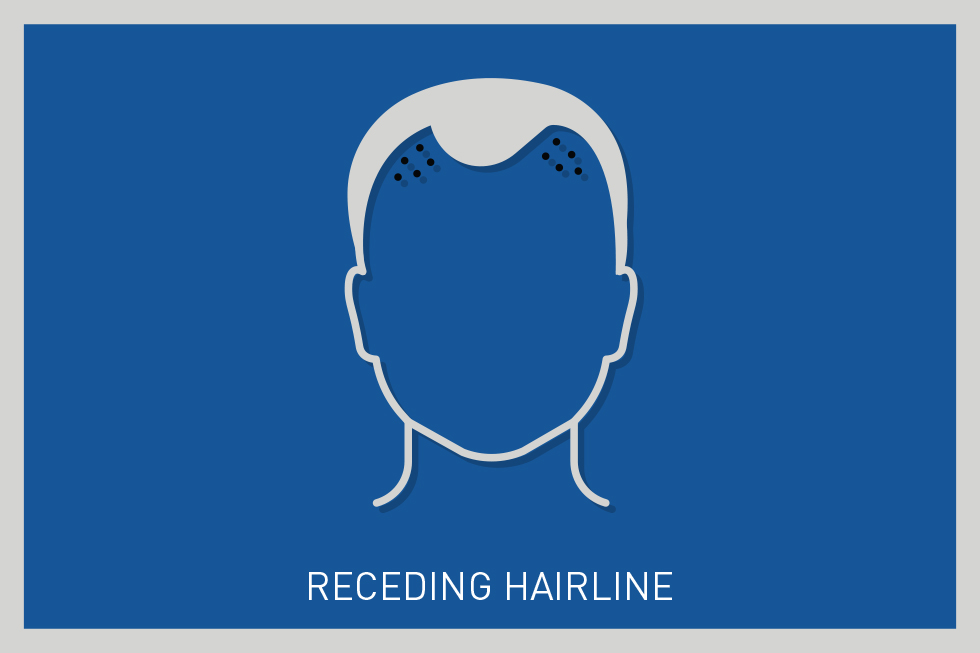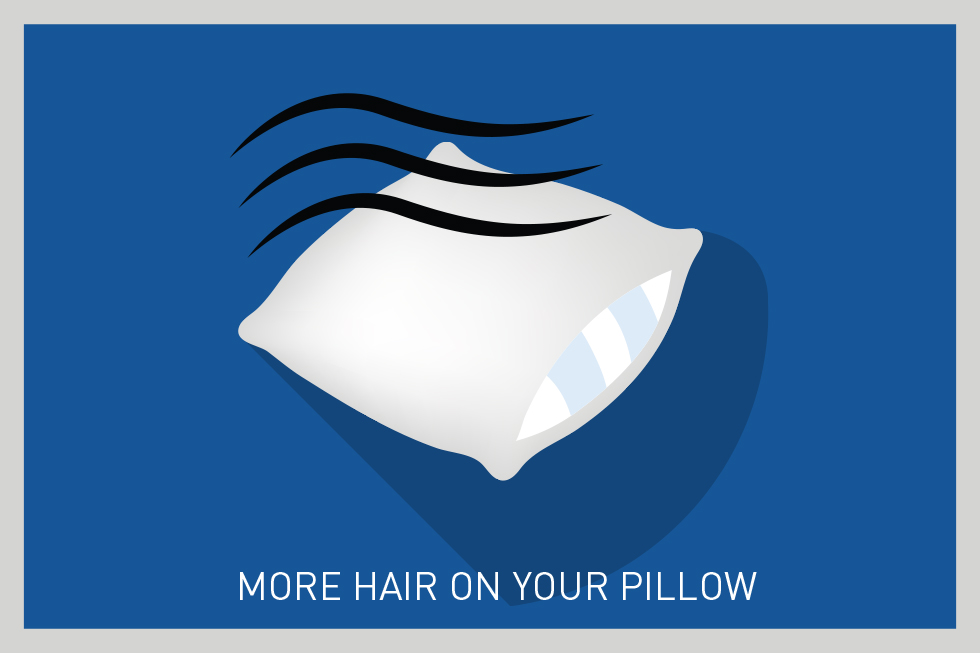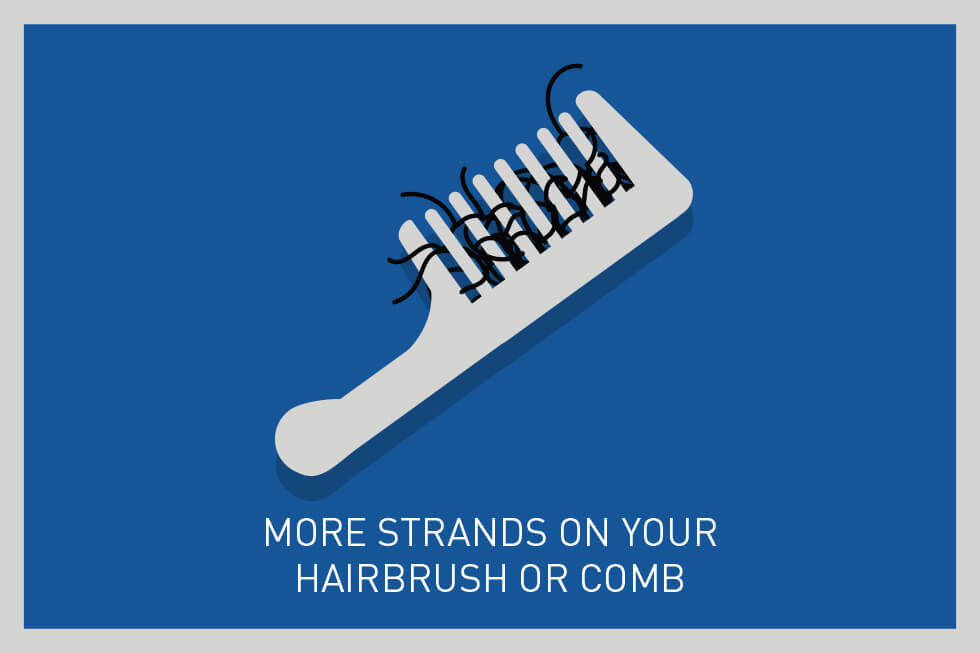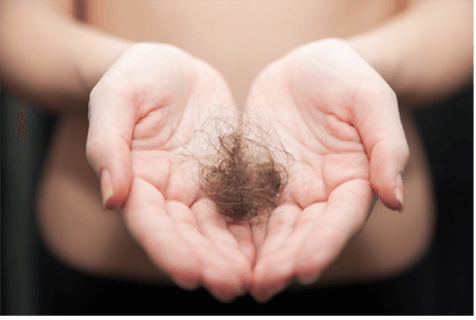Hereditary Hair Loss in Men
Up 2 out of 3 men experience some degree of appreciable hair loss by the age of 35. Whilst there are different types of hair loss, hereditary hair loss (or androgenetic alopecia) accounts for more than 95% of hair loss in men. Many men notice that it gets progressively worse as they age. Hereditary hair loss is a genetic condition which reduces the amount of time that hair actively spends growing. The hair at the temples and hairline begins to recede, and the crown starts to thin. Eventually, the hairline becomes so high that it joins up with the patch at the crown to create a completely bald scalp. 9,10,11,12,13
Signs & Symptoms of Male Hair Loss
Hair loss can appear in many different ways, depending on what's causing it. You may experience gradual thinning on the top of your head, circular or patchy bald spots or sudden loss of hair.29
Signs of Hereditary/Genetic Hair Loss
Not sure if you need hereditary hair loss treatment? Look to these early signs:

A receding hair line or widow’s peak
Hereditary hair loss typically begins with the receding of the hairline and the thinning of the hair.29 The best way to tell if you hair has receded is to find a picture of yourself from a year ago and make a comparison.

More hair on your pillow
We lose on average 30 to 150 hairs per day.30 If you see more than your usual amount of hair, this could be a sign of hereditary hair loss.

More hair in your comb or brush
Having a few hairs in your comb or brush is normal. If you start to see more than usual this could be a sign of hereditary hair loss.

More hair in the shower drain
Having a large amount of hair in the drain after washing your hair is a sign that you are losing more hair than normal.

Male Hair Loss Stages & Types
This diagram explains the stages of men’s hair loss. It is important to see your dermatologist for a correct diagnosis of your hair loss. Early treatment, in Stage 1/2 or 3 will result in the best outcomes.14 In fact the sooner you initiate your REGAINE® treatment, the more likely you will achieve the desired results.14
In men, hereditary hair loss also known as male pattern hair loss, typically starts with the receding of the hairline at the temples of the head creating a horseshoe shape, followed by the thinning of hair on the crown.34
When to See A Doctor for Hair Loss
You may feel embarrassed to go see your doctor if you have hair loss, but you should see them if you are distressed by persistent hair loss and want to pursue treatment options. You should also talk to your doctor if you notice any sudden, patchy hair loss or more than usual hair loss when combing or washing your hair. Sudden hair loss could be a sign of an underlying medical condition that requires treatment.
Speaking To A Healthcare Professional About Men's Hair Loss
When consulting a healthcare professional about your hair loss, you may feel unsure on what to say. Below are 4 steps to take before and during your consultation to help you:

STEP 1: Create a simple diary to track your hair health
Jot down a list of out-of-the-ordinary experiences you have been having with your hair, such as more frequent and/or larger clumps of hair in the drain after showering, or an increased number of strands on your pillow. Take these daily observations over a 1- to 2-month time period. These are all things you want to mention to your healthcare professional.

STEP 2: Feel free to bring the evidence
Jot down a list of all the self-diagnostic tools and tests you’ve used and the results from these tests. Bring them with you to your appointment. You may also bring photos of your scalp. Some men bring in clumps of hair in a plastic bag for their healthcare professional to examine. Don’t be shy. He or she is there to help you.

STEP 3: Tell your healthcare professional about lifestyle habits or changes that may be related to hair loss
Although hair loss can be due to genetic factors, remember that there are still other causes of hair loss in men, such as long-term everyday stress and, in more rare cases, a medical condition (perhaps related to your thyroid)15.

STEP 4: Inquire if any further testing is necessary
Expect your healthcare professional to ask further questions and to do a detailed review of your medical history covering topics such as recent surgeries or cancer treatments (chemotherapy or radiotherapy), and familial history of hereditary androgenetic alopecia (e.g. genetic hair loss).
FACTS ABOUT THINNING HAIR IN MEN

The average scalp is covered with 100,000 hair follicles.16
Most people lose between 30 and 150 hairs a day.30
Male pattern hair loss follows two predictable routes. A receding hair line and thinning at the crown.29
The earlier you treat your hereditary hair loss with REGAINE® the better your chances of seeing results are.14
REGAINE® contains minoxidil which is scientifically proven to help stop and even reverse hereditary hair loss.4
References:
4. REGAINE® SPC – Section 5.1.
9. Hadshiew IM, Foitzik K, Arck PC, Paus R. (2004). Burden of Hair Loss: Stress and the Underestimated Psychosocial Impact of Telogen Effluvium and Androgenetic Alopecia. Journal of Investigative Dermatology, 123 (3), 455-457.
10. American Hair Loss Association. (n.d). Men’s Hair Loss: Introduction. Retrieved May 7, 2020, from https://www.americanhairloss.org/men_hair_loss/introduction.html.
11. American Hair Loss Association. (n.d). Men’s Hair Loss: Treatment. Retrieved May 7, 2020, from https://www.americanhairloss.org/men_hair_loss/treatment.html.
12. Sinclair, R et al. Hair loss in women: medical and cosmetic approaches to increase scalp hair fullness. The British journal of dermatology, 165 Suppl 3, 12–18. 2011. https://doi.org/10.1111/j.1365-2133.2011.10630.x.
13. Bergfeld, W. F., & Mulinari-Brenner, F. (2001). Shedding: how to manage a common cause of hair loss. Cleveland Clinic journal of medicine, 68(3), 256–261.
14. Khandpur, S., Suman, M., & Reddy, B. S. (2002). Comparative efficacy of various treatment regimens for androgenetic alopecia in men. The Journal of dermatology, 29(8), 489–498.
15. American Hair Loss Association. (n.d.). Men’s Hair Loss: Causes of Hair Loss. Retrieved May 7, 2020, from https://www.americanhairloss.org/men_hair_loss/causes_of_hair_loss.html.
16. Shapiro J. (2007). Clinical practice. Hair loss in women. The New England journal of medicine, 357(16), 1620–1630.
29. Blumeyer, A., Tosti, A., Messenger, A., Reygagne, P., Del Marmol, V., Spuls, P. I., Trakatelli, M., Finner, A., Kiesewetter, F., Trüeb, R., Rzany, B., Blume-Peytavi, U., & European Dermatology Forum (EDF) (2011). Evidence-based (S3) guideline for the treatment of androgenetic alopecia in women and in men. Journal der Deutschen Dermatologischen Gesellschaft = Journal of the German Society of Dermatology: JDDG, 9 Suppl 6, S1–S57.
30. British Association of Dermatologists. (n.d.). Telogen effluvium. Retrieved June 13, 2021. https://www.bad.org.uk/patient-information-leaflets/telogen-effluvium/?showmore=1&returnlink=https%3A%2F%2Fwww.bad.org.uk%2Fpatient-information-leaflets#.YMWry5MzbvU.
31. Dinh, Q. Q., & Sinclair, R. (2007). Female pattern hair loss: current treatment concepts. Clinical interventions in aging, 2(2), 189–199.
34. British Association of Dermatologists. (2015). Hair loss - male pattern (androgenetic alopecia). Retrieved January 6, 2020, from https://www.bad.org.uk/for-the-public/patient-information-leaflets/androgenetic-alopecia.

